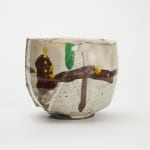Takauchi Shugo 髙內秀剛 b. 1937
Aka-e Tea Bowl, 2020
Stoneware
H3 7/8 × Dia 4 3/8 in.
H9.9 × Dia 11.2 cm
H9.9 × Dia 11.2 cm
With signed wood box
Further images
-
(View a larger image of thumbnail 1
)

-
(View a larger image of thumbnail 2
)

-
(View a larger image of thumbnail 3
)

-
(View a larger image of thumbnail 4
)

-
(View a larger image of thumbnail 5
)

-
(View a larger image of thumbnail 6
)

-
(View a larger image of thumbnail 7
)

-
(View a larger image of thumbnail 8
)

-
(View a larger image of thumbnail 9
)

Emerging from the Mashiko scene in Tochigi during the early 1970s, Takauchi Shugo (b. 1937) ascended to fame in his craft when he was selected in 1972 for the Japan...
Emerging from the Mashiko scene in Tochigi during the early 1970s, Takauchi Shugo (b. 1937) ascended to fame in his craft when he was selected in 1972 for the Japan Traditional Crafts Exhibition. His grasp of Mingei philosophies underscores his mastery of a diverse range of glaze types, resulting in a practice that produces functional, natural forms that also offer highly expressive modes and transform the spaces they inhabit.
His works have been showcased at prestigious venues such as the Mashiko Museum of Ceramic Art, the National Museum of Modern Art in Tokyo. The Tokyo Metropolitan Teien Art Museum, created pieces dedicated to his Buddhist practice at the Yakushiji Temple in Nara, and held numerous solo exhibitions at Mitsukoshi Nihonbashi and Takashimaya.
Internationally, his work has found a permanent place in the collections of renowned institutions like the Metropolitan Museum of Art and the Brooklyn Museum of Art, among others.
Despite his remarkable repertoire, Takauchi has led an unconventional life as a potter. He initially served as a salaryman in corporate Tokyo before relocating to Mashiko to construct his kiln, employing both gas and wood firing methods in 1968 after finding inspiration in the works of Hamada Shoji. This unconventional background has endowed him with the capacity to transcend the stylistic regionalism that characterized more traditional Mingei styles in the ceramic art industry from the 1940s to the 1970s. His expertise extends across a broad spectrum of glazes. This tea bowl uses Aka-e painted glaze over a white slip.
His works have been showcased at prestigious venues such as the Mashiko Museum of Ceramic Art, the National Museum of Modern Art in Tokyo. The Tokyo Metropolitan Teien Art Museum, created pieces dedicated to his Buddhist practice at the Yakushiji Temple in Nara, and held numerous solo exhibitions at Mitsukoshi Nihonbashi and Takashimaya.
Internationally, his work has found a permanent place in the collections of renowned institutions like the Metropolitan Museum of Art and the Brooklyn Museum of Art, among others.
Despite his remarkable repertoire, Takauchi has led an unconventional life as a potter. He initially served as a salaryman in corporate Tokyo before relocating to Mashiko to construct his kiln, employing both gas and wood firing methods in 1968 after finding inspiration in the works of Hamada Shoji. This unconventional background has endowed him with the capacity to transcend the stylistic regionalism that characterized more traditional Mingei styles in the ceramic art industry from the 1940s to the 1970s. His expertise extends across a broad spectrum of glazes. This tea bowl uses Aka-e painted glaze over a white slip.








